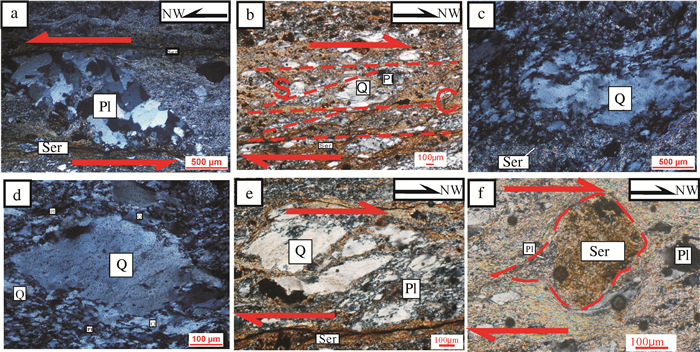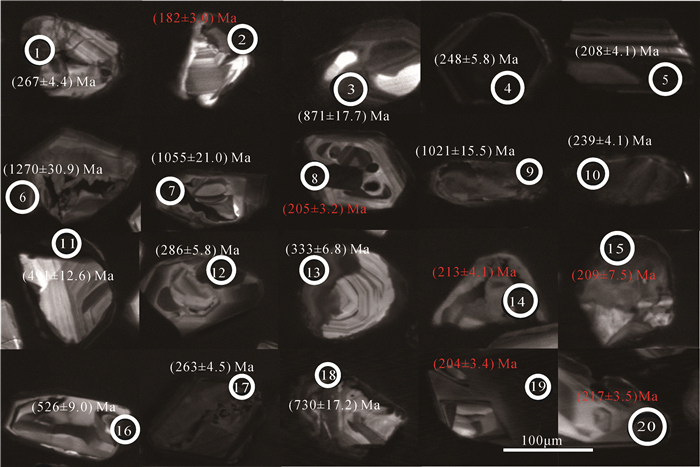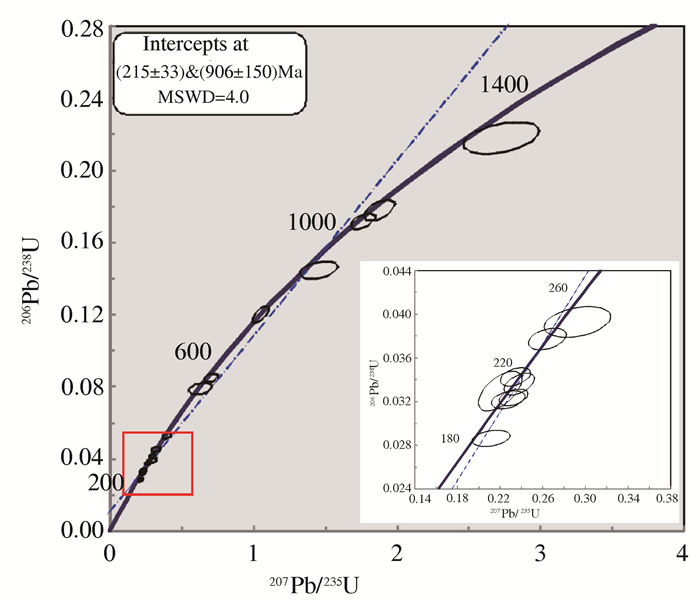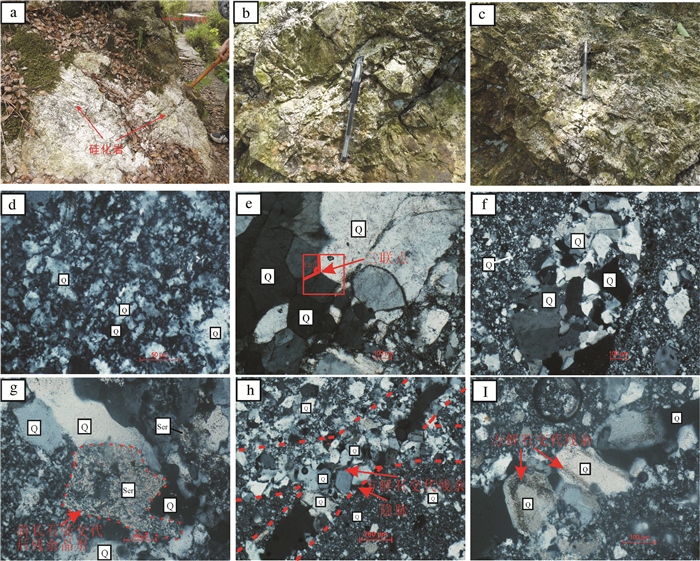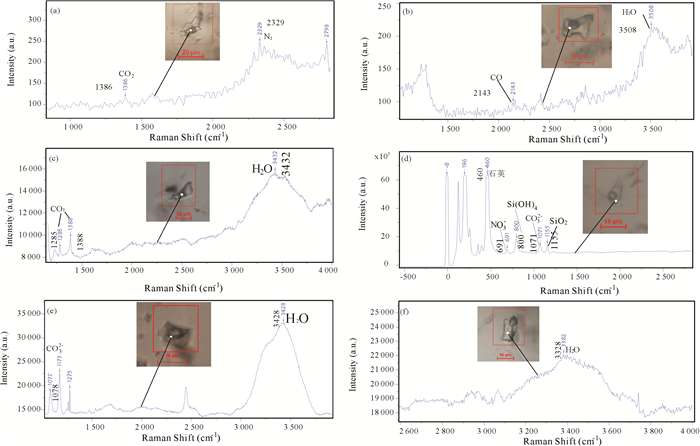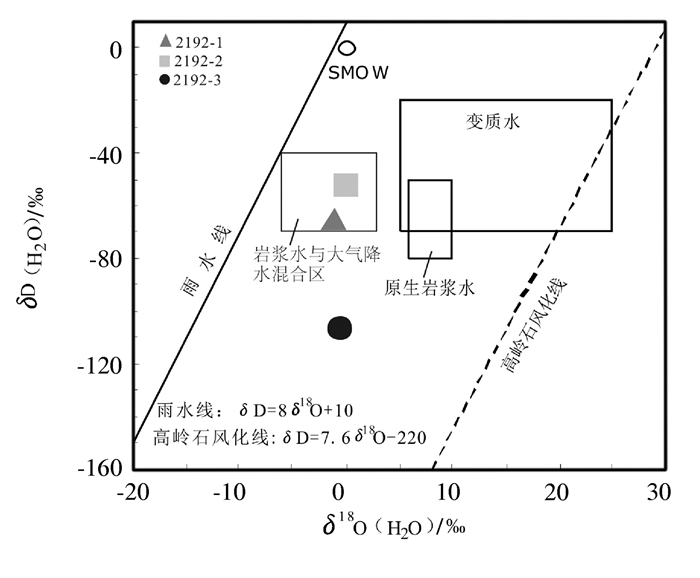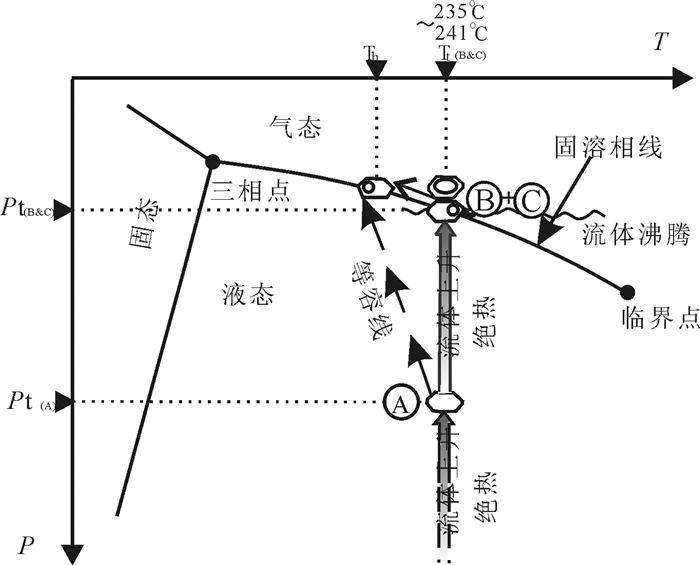Yanshanian thermo-upwelling extension and palaeo-hydrothermal system in southeast Guangdong: A case study of Enping-Xinfeng detachment fault
-
摘要:
粤东南地区广泛发育燕山期NE-SW走向的拆离断层系统。文章对恩平-新丰拆离断层进行了野外地质调查和室内测试分析,重点研究了拆离断层之下韧性剪切带中的糜棱岩和拆离断层上盘与高角度脆性正断层伴生的硅化岩。初步认为,研究区热隆伸展构造于燕山早期开始形成,糜棱岩的变形温度在350℃左右,硅化岩内石英中气液包裹体的均一温度在155℃~326℃,盐度在2.74%~21.61% NaCleqv,平均盐度为11.17% NaCleqv,古热液流体沸腾时的温度在235℃~241℃,激光拉曼光谱分析结果表明,含硅热液的成分为富含Si、CO2的NaCl-H2O溶液。硅化岩流体包裹体的H-O稳定同位素组成表明古水热流体为岩浆水与大气降水混合作用的产物。沿着正断层分布的硅化岩可能是燕山期古水热型地热能的重要标志。燕山期热隆伸展构造系统及其深层与浅层相结合的古水热系统对认识现代地热能的类型、成因及其分布规律有一定的意义。
Abstract:NE-SW trending Yanshanian detachment faults are widely spread in southeast Guangdong. The authors carried out geological survey and physical and chemical test of Enping-Xinfeng detachment fault, with emphasis placed on the mylonite in the ductile shear zone below this detachment fault and the silicified rocks related to the high angle normal fault on the hanging wall of the detachment fault. The authors believe that the initiation age of the upwelling-extension structure was in early Yanshanian, the deformation temperatures of the mylonite which had the kinematic property of ductile rheology in the ductile shear zone were about 350℃, and the mylonite was brought onto the surface during later tectonic uplift. The microthermometric study of the fluid inclusions in the silicified rocks indicates that the homogeneous temperatures of the fluid inclusions are between 155℃ and 326℃. The salinities are between 2.74% and 21.61% NaCleqv, with an average of 11.17% NaCleqv, the temperatures of the silicon-contained hot liquid are about 241℃, and the silicon-contained hot liquid is believed to be NaCl-H2O solution with rich silicon and carbon dioxide according to Laser-Raman microspectroscopy. Compositions of H-O stable isotope imply that the paleo-hydrothermal fluids were derived from the mixing of magmatic water and rain water in the study area. The silicified rocks distributed along the strike of the normal fault possibly are the significant indications of the paleo-hydrothermal system in Yanshanian. The thermo-upwelling extension system and the deep and shallow integrated palaeo-hydrothermal system in the late Yanshanian are significant for the understanding of the type, the mechanism and the distribution regularities of the modern geothermal system in southeast Guangdong.
-
1. 引言
热隆伸展构造是在区域伸展的背景下岩浆侵入造成区域地壳热软化,继而发生固态流变引起区域热隆伸展的结果,岩浆侵入带来的巨大热量及其分异所产生的巨量岩浆水造成区域地壳应变软化,继而发生韧性流动并与上部的韧脆性转换带发生力学解耦(傅昭仁等,1992; 李德威,1992; 李德威,1993; 李德威,1994; 李德威等,2003; 李德威,2004; ),根据Columb-Mohr断层准则的预测,本区域将会产生多个世代的低角度正断式拆离断层,在多个世代的拆离断层的作用下,拆离断层下盘的基底岩层会逐渐向上剥露,之前在地下深处的韧性剪切带糜棱岩则会剥露于地表(Lister et al., 1989),拆离断层上盘的沉积岩层在多个世代拆离断层拆离减薄的作用下不断减薄,产生多个时代的地层缺失现象。吴甲添等(2001)研究广东省燕山期河源拆离断层后认为,研究区燕山期花岗质岩浆的侵入作用对于伸展拆离断层的形成起到了决定性的作用。研究热隆伸展构造域铀成矿关系后认为,在伸展构造体制下的同构造岩浆活动是热隆伸展构造体系内的重要特征。拆离断层及其上盘脆性变形域为岩浆水的上升和地表大气水的下渗提供了减压扩容空间(李德威,2005),容易形成本区域的水热型地热系统。
国内对热隆伸展构造与地热能系统之间关系的研究较为薄弱,对韧性剪切带及其上部韧脆性变形带和水热型地热能体系的理论研究也几乎是空白(李德威,2015)。笔者前期在粤东南NE向的海陵—恩平—苍城断裂北段新发现了一个典型的燕山期热隆伸展构造,在该热隆伸展构造系统中,我们发现了一条典型的燕山期拆离断层,在其上盘还发现了一条由于含硅热液上涌引起围岩硅化蚀变而形成的硅化岩带,伸展拆离断层附近的糜棱岩带露头良好,是研究热隆伸展构造与古水热型地热能的良好地带。本文拟在海陵—恩平—苍城断裂野外地质调查以及硅化岩内石英矿物中气液包裹体显微测温实验以及成分分析的基础上,对新发现的北东向恩平—新丰断裂西南段西束的伸展拆离断层及古地热系统进行初步的研究,以期对粤东南伸展拆离体制下形成的水热型地热能以及二者之间关系的理论研究加以补充。
2. 研究区热隆伸展构造特征及年代学
2.1 研究区热隆伸展构造地质特征
李三忠等(2017)通过总结、归纳、分析华南陆块中生代褪皱构造变形的时间和期次、德兴矿斑岩形成时间以及白垩纪华南的盆地断裂格局后,认为中国东南部在燕山早期即已发生EW向古特提斯构造域向NE、NNE向西太平洋构造域的动力体制转换,并且出现伸展构造体制(李三忠等,2017)。舒良树和周新民(2002)认为中国东南部侏罗纪盆地内双峰式火山岩以及A型花岗岩的出现标志着中国东南部在燕山早期经历了一次从EW向古亚洲构造域向NE向西太平洋构造域的体制转换,在侏罗纪完成了挤压到拉张的构造转换。燕山晚期中国东南部主要受西太平洋构造域伸展构造体制控制,早白垩世以来形成了大量NE、NNE向的线性伸展盆地以及NE向的断裂体系,20世纪90年代以来,在广东省相继发现了云开变质基底双拆离型伸展拆离构造、云开地块周边伸展拆离构造、高明—高要伸展拆离构造以及河源伸展拆离构造(彭少梅,1999)。近年来,沿着广东NE向的断裂带发现了大量的温泉(图 1a),反映这些NE向断裂是地表以下巨量地热能的释热通道,本次研究工作中发现的热隆伸展构造位于海陵—恩平—苍城断裂带(图 1-b)之上。海陵—恩平—苍城断裂带是北东向恩平—新丰大断裂三水盆地以南的部分,总体走向25°~ °,倾向NW,倾角° ~60°,长约160 km。根据地质地貌特征,海陵—恩平—苍城断裂可以分为南、中、北三段(张珂,1999),南段主要是指恩平以南至海陵岛,陆上长约50 km,断层泥、挤压破碎带等压性现象较为常见,局部可见逆断层地貌; 中段主要是指恩平至苍城之间的地段,长约40 km,与南段相似,中段也常见挤压性构造地貌; 北段是指苍城以北至高明三洲的地段,长约50 km,与中段和南段相比,北段表现出更为强烈的张性活动特征(图 1b)。
从研究区地形图(图 2a)中可以看出,研究区发育了一个NE向长垣状隆起地形,隆起地形的海拔高度在700 m左右,隆起地形与两侧低平地形形成了鲜明的对比,从研究区的遥感图片(图 2b)中可以识别出海陵—恩平—苍城断裂,此处这一断层为一高角度正断层,断层的倾向为316°,倾角为58°,西侧的早侏罗世二长花岗岩(J11ηγ)通过此断层与晚三叠世小坪组(T3x)呈断层接触。沿着出海陵—恩平—苍城断裂的走向分布有一条呈灰白色的硅化岩带,宽度在30~40 m,在海陵—恩平—苍城断裂两侧可见地表植被分布具有明显的差异,这种差异现象的出现可能与研究区地形和现今仍然活动着的热水活动所引起的土壤化学环境变化有关。
根据野外实测数据,绘制研究区热隆伸展构造剖面图(图 3),如图 3a所示,研究区热隆伸展构造具有类似变质核杂岩的双层结构,包括拆离断层之下由中寒武统高滩组(Є2g)浅变质岩系和早侏罗世二长花岗岩所构成的基底岩层以及拆离断层之上由晚三叠统小坪组(T3x)地层所构成的脆性盖层,属于具有类似变质核杂岩几何学特征的浅层次热隆伸展构造。中寒武统高滩组(Є2g)地层的主要岩性为炭质板岩、绢云母板岩、粉砂岩以及灰绿、黄绿色变余不等粒长石石英砂岩,为一套复理石变质碎屑岩系,厚度为900~1960 m,晚三叠统小坪组(T3x)岩性主要为白色、灰白色、灰黄色砂岩、石英砂岩以及砂砾岩,厚度在14.1~810.0 m,其地层产状与其下拆离断层产状近似,小坪组中部含我国南方晚三叠世卡尼期的重要分子日置类贝荚蛤(Bakevelloides heikiensis)、长型古筍蛤(Palaeophorus oblongatus)等,时代为晚三叠世。
小坪组之下为中间拆离断层,在其地表露头部分测得倾向为312°,倾角为25°,在这条铲式拆离断层下部,原岩多发生动力变质作用形成糜棱岩(图 3b~d),形成研究区韧性剪切带,在韧性剪切带地表露头部分,测得糜棱岩面理的倾向为308°,倾角为22°,如图 3所示,在糜棱岩顶部靠近拆离断层处,可见岩石强烈构造破碎,形成沿着拆离断层分布的碎裂岩。糜棱岩由基质和碎斑组成,基质主要由石英、绢云母的微粒组成,含量大于50%,观察糜棱岩的新鲜面可以清楚地看到石英、绢云母被很大程度上拉长,石英被拉成丝状,石英与绢云母韧性变形较为明显,从手标本上可以看见石英与绢云母定向排列,形成明显的面状构造和拉伸线理,碎斑(图 4a)主要由斜长石、石英等硬矿物组成并以斜长石居多,斜长石韧性变形现象少见,多为脆性破裂,根据碎斑矿物的旋转方向及其拖尾、拉伸线理、S-C组构(图 4b)等运动学标志,判断糜棱岩具有SE-NW向剪切的运动学性质,没有发现角闪石、辉石及其韧性变形现象。糜棱岩的主要组成矿物为石英、斜长石和绢云母,石英和绢云母具有明显的韧性流动构造(图 4b),斜长石呈脆性破裂,石英具有非均匀波状消光(图 4c)和动态重结晶现象(图 4d),可见细小的石英动态重结晶颗粒围绕着大的石英颗粒分布,形成了糜棱岩中较为典型的显微构造——核幔构造(图 4d),在糜棱岩中可见由石英构成的书斜式构造(图 4e),指示NW向剪切,还可以看见斜长石的σ碎斑拖尾,斜长石旋斑被绢云母交代,保留旋斑原始形状,指示SE-NW向剪切(图 4f),斜长石旋斑被绢云母交代并保留斜长石交代残余现象的出现说明糜棱岩曾经经历过水热蚀变。这些矿物组合和变形方式指示糜棱岩变质相为绿片岩相(Gapais,1989; Tullis et al., 1997; Zhou et al., 2000; Cai,2012),属于绿片岩相糜棱岩。对于其变形温度,由于样品本身的原因(石英流体包裹体太小、太少)而无法通过显微测温得到定量结果,根据其矿物组合以及变形特征结合前人的研究成果可以得到一个半定量结果,变形温度在350℃左右,根据前人的研究成果,糜棱岩所处的环境可能位于韧性变形带向脆性变形过渡的韧脆性转换带中,但是从岩石样品本身来看,岩石具有明显的韧性变形现象,故认为其位于韧性剪切带中,但是其深度不会很深,为6~8 km,比较接近脆性变形域。结合糜棱岩显微构造的运动学标志和糜棱岩野外特征,可以清楚地判断糜棱岩所处的韧性剪切带具有自SE向NW韧性流动的特征。
![]() 图 4 海陵—恩平—苍城断裂带北段韧性剪切带中糜棱岩显微照片a—碎斑由斜长石(Pl)和石英(Q)组成, 石英具有波状消光, 斜长石可见脆性破裂现象, 绢云母(Ser)颗粒细小, 并呈线状流动构造, 韧性变形明显, 正交偏光; b—韧性变形的绢云母(Ser)围绕石英(Q)和斜长石(Pl)组成的旋转碎斑呈线性流动构造, 构成糜棱岩的S−C组构; c—石英碎斑(Q)具有波状消光, 反映石英矿物晶体内部由于韧性变形作用发生晶内变形, 碎斑周围被细小的重结晶颗粒围绕, 反映重结晶现象较为明显, 正交偏光; d—碎斑为石英(Q), 由碎斑向外依次变为石英亚颗粒、重结晶颗粒, 为典型的核幔构造, 正交偏光; e—石英(Q)碎斑构成的书斜式构造, 指示NW剪切, 正交偏光; f—斜长石(Pl)的σ碎斑拖尾, 它被绢云母(Ser)交代, 保留斜长石碎斑原始形状, 反应水热蚀变现象的存在Figure 4. Microphotographs of mylonite from ductile shear zone in the north section of Hailing−Enping−Cangcheng fault zonea − Porphyroclasts consisting of plagioclase (Pl) and quartz (Q), undulatory extinction can be seen in quartz, brittle fractures are common in plagioclases, sericite (Ser) is fine−grained and linear flow and ductile deformation microstructures are evident, crossed nicols; b− Porphyroclasts consisting of plagioclases (Pl) and quartz (Q) are surrounded by ductile deformed sericites, both of which constitute S−C fabric, crossed nicols; c−Quartz exhibiting undulatory extinction, which indicates that intracrystalline deformations exist in quartz, quartz porphyroclasts are surrounded by fine−grained recrystallized grains, which indicate that recrystallization is common in quartz, crossed nicols; d−Porphyroclasts are quartz, which are surrounded by quartz subgrains and its recrystallized grains from inner to external part correspondingly, which constitute core − mantle structure, crossed nicols; e − Quartz porphyroclasts constitute Domino − type microstructure, which indicates NW shearing, crossed nicols; f − The σ porphyroclastof plagioclase (Pl), which was altered by sericite while the original appearance remained, indicating that hydrothermal alternation is common
图 4 海陵—恩平—苍城断裂带北段韧性剪切带中糜棱岩显微照片a—碎斑由斜长石(Pl)和石英(Q)组成, 石英具有波状消光, 斜长石可见脆性破裂现象, 绢云母(Ser)颗粒细小, 并呈线状流动构造, 韧性变形明显, 正交偏光; b—韧性变形的绢云母(Ser)围绕石英(Q)和斜长石(Pl)组成的旋转碎斑呈线性流动构造, 构成糜棱岩的S−C组构; c—石英碎斑(Q)具有波状消光, 反映石英矿物晶体内部由于韧性变形作用发生晶内变形, 碎斑周围被细小的重结晶颗粒围绕, 反映重结晶现象较为明显, 正交偏光; d—碎斑为石英(Q), 由碎斑向外依次变为石英亚颗粒、重结晶颗粒, 为典型的核幔构造, 正交偏光; e—石英(Q)碎斑构成的书斜式构造, 指示NW剪切, 正交偏光; f—斜长石(Pl)的σ碎斑拖尾, 它被绢云母(Ser)交代, 保留斜长石碎斑原始形状, 反应水热蚀变现象的存在Figure 4. Microphotographs of mylonite from ductile shear zone in the north section of Hailing−Enping−Cangcheng fault zonea − Porphyroclasts consisting of plagioclase (Pl) and quartz (Q), undulatory extinction can be seen in quartz, brittle fractures are common in plagioclases, sericite (Ser) is fine−grained and linear flow and ductile deformation microstructures are evident, crossed nicols; b− Porphyroclasts consisting of plagioclases (Pl) and quartz (Q) are surrounded by ductile deformed sericites, both of which constitute S−C fabric, crossed nicols; c−Quartz exhibiting undulatory extinction, which indicates that intracrystalline deformations exist in quartz, quartz porphyroclasts are surrounded by fine−grained recrystallized grains, which indicate that recrystallization is common in quartz, crossed nicols; d−Porphyroclasts are quartz, which are surrounded by quartz subgrains and its recrystallized grains from inner to external part correspondingly, which constitute core − mantle structure, crossed nicols; e − Quartz porphyroclasts constitute Domino − type microstructure, which indicates NW shearing, crossed nicols; f − The σ porphyroclastof plagioclase (Pl), which was altered by sericite while the original appearance remained, indicating that hydrothermal alternation is common2.2 研究区热隆伸展构造地质年代学
研究区二长花岗岩岩体侵入于晚三叠世小坪组(T3x)地层之下,并被中侏罗世花岗岩体侵入,获K-Ar同位素年龄值为146.2~200 Ma,U-Pb同位素年龄值为(156±4) Ma、175 Ma,Rb-Sr同位素年龄值为186 Ma。综合野外和同位素年龄资料,其形成时代确定为早侏罗世第一阶段❶。对糜棱岩中变质锆石进行阴极发光照相(图 5),从阴极发光图片中可以看出大部分变质锆石具有半自形以及磨圆的外形特征,部分变质锆石具有由原岩碎屑锆石和后期变质增生边构成的核-边结构,对变质锆石进行LA- ICP-MS原位微区定年,所获定年结果如表 1所示。所测20颗锆石中的12颗锆石Th/U比值小于0.4,其中7颗锆石的Th/U比值小于0.1,锆石CL图像所反映的锆石内部结构特征以及Th/U比值特征暗示所测锆石具有变质锆石的特征(吴元保和郑永飞,2004; 陈道公,2005)。将年龄数据中两个谐和度低于90%的年龄去除,对其余年龄进行谐和图解投图,结果如图 6所示。谐和图的下交点可能反映研究区糜棱岩变质锆石记录了一次晚三叠世的变质事件,年龄在(215±33) Ma左右,锆石年龄结果中(239±4.1)Ma~(1270±30.9)Ma的年龄值反映的是变质锆石继承核或继承核与锆石增生边之间的混合年龄。从变质锆石的年龄数据结果(表 1)来看,其中有6颗锆石年龄反映的是变质锆石增生边的年龄,年龄值介于(180±3.0) Ma~(217±3.5) Ma,对其进行加权平均,获得了(201±15) Ma的年龄。焦骞骞等(2017)对广东河台金矿韧性剪切带中的糜棱岩热液锆石进行了LA ICP-MS锆石U-Pb定年,结果显示韧性剪切带中的初糜棱岩的加权平均年龄为204 Ma;Zhang and Cai (2009)利用河台金矿糜棱岩白云母进行39Ar-40Ar定年,获得了213~195 Ma的年龄结果;结合研究区在早侏罗世出现的岩浆侵位事件,本文认为研究区糜棱岩中的变质锆石记录了一次燕山早期由岩浆底侵作用导致的变质事件。结合研究区野外地质资料,本文初步认为,研究区的热隆伸展构造于燕山早期开始形成。
表 1 糜棱岩变质锆石定年结果Table 1. Dating results of metamorphic zircons in mylonite
3. 热隆伸展构造区古水热特征
3.1 热隆伸展构造区硅化岩的岩相学特征
本次研究工作所发现的硅化岩位于拆离断层西北侧的高角度正断层附近(图 2b,图 3a,图 7),宽30~40 m,颜色以灰白色与灰黄色为主,硅化岩的围岩为小坪组(T3x)砂岩,本文认为这些硅化岩是在燕山期西太平洋构造域伸展拉张背景下含硅热水通过研究区热隆伸展构造系统中海陵正断层以及岩石裂隙上升至地表附近,引起地表附近的原岩发生水热蚀变形成。在水热交代蚀变作用下,岩石发生强烈的弥漫状硅化蚀变,原岩的矿物被大量的交代,形成大量他形至半自形的粒状石英和微晶硅质(图 7d),石英含量大于90%,石英颗粒粒径普遍小于0.3 mm,通过镜下观察,发现硅化岩具有典型的半自形晶粒状镶嵌结构(图 7e),此外,硅化岩具有斑杂状构造(图 7f),在显微镜下,可以分出斑块和围绕斑块分布的基体,斑块由颗粒粒径较大的石英颗粒组成,颗粒平均粒径大于0.1 mm,具有粒状镶嵌变斑晶结构,基体由石英、绢云母和斜长石组成,颗粒粒径较小,其中斜长石被绢云母交代形成绢云母集合体(图 7g),保持着原来斜长石的形状,由于水热交代成因的绢云母无法达到K-Ar定年测试所需要的纯度,因而本次研究并没有绢云母年龄测试来限定硅化作用的年龄。在显微镜下观察,可发现硅化岩中存在隐脉状构造(图 7h),隐脉主要由石英组成,石英主要为交代石英,粒径多在0.2 mm左右,具有交代残余结构,在石英颗粒的边部保留了方解石的交代残余(图 7i),而且方解石的交代残余较为常见,本文认为硅化岩的原岩可能为处在砂岩和石灰岩过渡区域的含有方解石的砂岩,隐脉是一种粗看是脉、细看非脉的脉体(靳西祥等,1995; 谭运金等,2002),隐脉和其周围的矿物看上去有着截然的界线,实际上二者之间是逐渐过渡的,二者的矿物组成相同,均是石英,结构类似,均为粒状镶嵌结构,二者的区别在于隐脉中的石英颗粒粒径更大、自形程度更高(隐脉中石英多为半自形晶,而其周围石英多为他形晶)。
![]() 图 7 硅化岩野外照片以及显微照片a~c:硅化岩野外照片; d—他形至半自形的粒状石英(Q), 颗粒粒径较小, 多数小于0.05 mm, 可见粒状镶嵌结构; e—半自形至自形石英(Q)颗粒组成的较为典型的粒状镶嵌结构, 可见半自形的石英颗粒晶体形成了三联点, 三联点的夹角为120°; f—可见斑杂构造, 由斑块和基体构成, 斑块由石英(Q)组成, 具有镶嵌变斑晶结构; g—可见半自形石英(Q)、绢云母(Ser), 可见斜长石被绢云母交代形成绢云母集合体, 斜长石保持着原始晶体的外形; h—可见隐脉状构造, 隐脉中的矿物与其周围矿物相同, 均为石英(Q), 隐脉中的石英矿物颗粒的粒径明显大于周围矿物的粒径, 自形程度也更高, 二者之间的边界呈过渡状; i—可见石英(Q)颗粒的边部保持着方解石(Cc)的交代残余, 硅化岩原岩可能为处在砂岩和石灰岩过渡区域的含方解石的砂岩Figure 7. Hand specimens and microphotographs of silicified rocka-c: Hand specimens and micrographs of silicified rocks, on which the blowholes and breccias can be seen; d- Anhedral to subhedral quartz (Q) whose diameters are mostly less than 0.05mm, the grain-like structure can be seen; e-Subhedral to enhedral quartz constitutes grain-like structure, on which the triple junction is evident, the intersection angle of those junctions is 120°; f-Taxitic structure which consists of quartz, exhibiting grainlike structure; g-Subhedral quartz and sericite can be seen, the plagioclases were altered by sericites, which constitute the aggregation of sericites while the original appearance of plagioclases remained; h- Blind vein structure in which the minerals are mostly quartz, the same as minerals surrounding it, while quartz in blind veins has well enhedral shape compared with the surrounding quartz; i- Alternation remnants of calcites remained at the edge of quartz grains, which indicates that the country rock may be calcite-bearing sandstone
图 7 硅化岩野外照片以及显微照片a~c:硅化岩野外照片; d—他形至半自形的粒状石英(Q), 颗粒粒径较小, 多数小于0.05 mm, 可见粒状镶嵌结构; e—半自形至自形石英(Q)颗粒组成的较为典型的粒状镶嵌结构, 可见半自形的石英颗粒晶体形成了三联点, 三联点的夹角为120°; f—可见斑杂构造, 由斑块和基体构成, 斑块由石英(Q)组成, 具有镶嵌变斑晶结构; g—可见半自形石英(Q)、绢云母(Ser), 可见斜长石被绢云母交代形成绢云母集合体, 斜长石保持着原始晶体的外形; h—可见隐脉状构造, 隐脉中的矿物与其周围矿物相同, 均为石英(Q), 隐脉中的石英矿物颗粒的粒径明显大于周围矿物的粒径, 自形程度也更高, 二者之间的边界呈过渡状; i—可见石英(Q)颗粒的边部保持着方解石(Cc)的交代残余, 硅化岩原岩可能为处在砂岩和石灰岩过渡区域的含方解石的砂岩Figure 7. Hand specimens and microphotographs of silicified rocka-c: Hand specimens and micrographs of silicified rocks, on which the blowholes and breccias can be seen; d- Anhedral to subhedral quartz (Q) whose diameters are mostly less than 0.05mm, the grain-like structure can be seen; e-Subhedral to enhedral quartz constitutes grain-like structure, on which the triple junction is evident, the intersection angle of those junctions is 120°; f-Taxitic structure which consists of quartz, exhibiting grainlike structure; g-Subhedral quartz and sericite can be seen, the plagioclases were altered by sericites, which constitute the aggregation of sericites while the original appearance of plagioclases remained; h- Blind vein structure in which the minerals are mostly quartz, the same as minerals surrounding it, while quartz in blind veins has well enhedral shape compared with the surrounding quartz; i- Alternation remnants of calcites remained at the edge of quartz grains, which indicates that the country rock may be calcite-bearing sandstone3.2 硅化岩气液包裹体的均一温度、盐度及成分信息
本次研究所发现的微米级气液包裹体的寄主矿物均为石英(图 7),石英主要是交代作用下形成的石英,多为他形至半自形晶,自形晶少见,在高倍光学显微镜下观察,可见大量气液两相包裹体(图 8a,8d~f,8h),气液三相包裹体(图 8b,8c)相对少见,气液两相包裹体和气液三相包裹体的大小均在5~22 µm,发现的最大的包裹体大小在20~22 µm,且为气液三相包裹体(图 8c),气液包裹体形状多为不规则状、椭圆形,负晶形少见(图 8d),气液包裹体多呈孤立、分散、随机分布,偶尔可见包裹体呈带状分布(图 8i),气液两相和三相包裹体均为原生气液包裹体(Donatienne et al., 2002; Sjoukje et al., 2007)。
![]() 图 8 硅化岩内流体包裹体显微照片V—包裹体中的气相; L—包裹体中的液相; a—原生气液两相包裹体, 包裹体形状不规则, 呈孤立状分布; b—原生气液三相包裹体, 包裹体大小在10~20 µm, 形状不规则, 孤立分布; c—原生气液三相包裹体, 包裹体大小在20~22 µm, 形状不规则, 孤立分布; d—原生气液两相包裹体, 形态为椭圆形、不规则状; e—原生气液两相包裹体, 为负晶形, 大小在10 µm左右; f—原生气液两相包裹体; g—原生富CO2气相包裹体, 大小在10~15 µm; h—原生气液两相包裹体, 大小约为10 µm; i—原生气液两相包裹体, 包裹体较小, 可见包裹体约呈条带状分布Figure 8. Microphotographs of fluid inclusions in silicified rockV- Gaseous phase in fluid inclusions; L- Liquid phase in fluid inclusions; a- Primary liquid- gaseous fluid inclusions with irregular shape; b- Primary liquid- liquid- gaseous triphase fluid inclusions with diameters range from 10 to 20 µm, exhibiting irregular shape, in isolated distribution; c-Primary liquid-liquid-gaseous triphase fluid inclusions with diameters range from 20 to 22 µm, exhibiting irregular appearance, in isolate distribution; d- Primary liquid-gaseous fluid inclusions with ellipitic shape; e- Primary liquid-gaseous fluid inclusions with negative crystal structure, whose diameters are about 10 µm; f- Primary liquid-gaseous fluid inclusions; g- Primary carbon dioxide gaseous rich fluid inclusions with diameters ranging from 10 to 15 µm; h- Primary liquid- gaseous fluid inclusions with diameters about 10 µm; i-Primary liquid-gaseous fluid inclusions with ribbon-like structure
图 8 硅化岩内流体包裹体显微照片V—包裹体中的气相; L—包裹体中的液相; a—原生气液两相包裹体, 包裹体形状不规则, 呈孤立状分布; b—原生气液三相包裹体, 包裹体大小在10~20 µm, 形状不规则, 孤立分布; c—原生气液三相包裹体, 包裹体大小在20~22 µm, 形状不规则, 孤立分布; d—原生气液两相包裹体, 形态为椭圆形、不规则状; e—原生气液两相包裹体, 为负晶形, 大小在10 µm左右; f—原生气液两相包裹体; g—原生富CO2气相包裹体, 大小在10~15 µm; h—原生气液两相包裹体, 大小约为10 µm; i—原生气液两相包裹体, 包裹体较小, 可见包裹体约呈条带状分布Figure 8. Microphotographs of fluid inclusions in silicified rockV- Gaseous phase in fluid inclusions; L- Liquid phase in fluid inclusions; a- Primary liquid- gaseous fluid inclusions with irregular shape; b- Primary liquid- liquid- gaseous triphase fluid inclusions with diameters range from 10 to 20 µm, exhibiting irregular shape, in isolated distribution; c-Primary liquid-liquid-gaseous triphase fluid inclusions with diameters range from 20 to 22 µm, exhibiting irregular appearance, in isolate distribution; d- Primary liquid-gaseous fluid inclusions with ellipitic shape; e- Primary liquid-gaseous fluid inclusions with negative crystal structure, whose diameters are about 10 µm; f- Primary liquid-gaseous fluid inclusions; g- Primary carbon dioxide gaseous rich fluid inclusions with diameters ranging from 10 to 15 µm; h- Primary liquid- gaseous fluid inclusions with diameters about 10 µm; i-Primary liquid-gaseous fluid inclusions with ribbon-like structure本文对石英矿物中的流体包裹体进行了详细的观察,并进行了显微测温以及包裹体成分分析,在此基础上本文将本次所研究的流体包裹体分为3种类型:
A型:属于H2O溶液包裹体(图 8a,8d,8e),包括纯H2O液相包裹体(图 8e)和H2O气液两相包裹体(图 8a,8d),H2O气液两相包裹体中包括H2O液相和H2O气相。
B型:属于CO2-H2O气液两相包裹体(图 8f,8h),这种类型的包裹体包括H2O液相和CO2气相(包裹体中的气泡)。
C型:这种类型的包裹体包括CO2-H2O气液三相包裹体(图 8b,8c)和富CO2气相包裹体(图 8g),CO2-H2O气液三相包裹体包括一个H2O液相、一个CO2液相和一个CO2气相。
本文对从野外(图 2)系统采集的硅化岩样品进行了室内显微测温,所用仪器为英国产LinkamTHMSG600冷热台(-196~600℃),采用美国FLUIDINC公司的人工合成流体包裹体标准样品进行温度校正。测试过程的升温速率一般为5~10℃/min,相转变点附近(如水溶液包裹体的冰点,各类包裹体的完全均一温度)的升温速率降低为0.5~1℃/min。对于气液两相水溶液包裹体,测定完全均一温度和冰点温度,利用Hall et al. (1988)的盐度-冰点公式计算流体盐度,通过系统采样,选择了2块新鲜的硅化岩样品,分别编号为2192-1与2192-2,分别在每个样品的不同部位切制了3块厚度为100 μm、双面抛光的标准测温薄片,显微测温结果如表 2所示。
表 2 宅梧镇硅化岩内石英矿物中流体包裹体特征及显微测温参数Table 2. Characteristics and microthermometry parameters of fluid inclusions in quartz from silicified rock in Zhaiwu area
2192-1-1样品内气液包裹体的均一温度在180~283℃,盐度在5.1% ~17.96% NaCleqv,平均为11.42% NaCleqv;2192-1-2样品内的气液包裹体的均一温度在168~280℃;盐度在2.74% ~19.6% NaCleqv,平均为7.07%NaCleqv;2192-1-3样品内的气液包裹体的均一温度在172~261℃,盐度在3.06% ~20.3% NaCleqv,平均为9.2% NaCleqv;2192-1样品的平均盐度为9.23% NaCleqv。2192-2-1样品内气液包裹体的均一温度在155~260℃,盐度在5.86%~ 13.51% NaCleqv,平均为9.71% NaCleqv;2192-2-2样品内的气液包裹体的均一温度在239~301℃,盐度在11.58% ~17.96% NaCleqv平均为14.05% NaCleqv;2192-2-3样品内的气液包裹体的均一温度在170~ 326℃,盐度在8.41% ~21.61% NaCleqv,平均为15.71% NaCleqv;2192-2样品的平均盐度为13.15% NaCleqv。第一件样品2192-1三块测温薄片中富液相包裹体的均一温度范围为168~ 298℃,均一温度平均值范围为221.9~233.5℃。富气相包裹体的均一温度范围为217~283℃,均一温度平均值范围为239.3~248.2℃。富液相包裹体与富气相包裹体均一温度平均值范围为221.9~248.2℃,二者均一温度大致相同,因而认为热液流体曾经经历过流体沸腾作用(Goldstein,1994; Ramboz,1982; 范宏瑞,2003; 卢焕章,2004)。
从流体包裹体均一温度分布直方图(图 9a)中可以看出,2192-1样品的均一温度在194~246℃居多,包裹体主要均一至液相,从图 9b中可以看出,2192-2样品的均一温度在207~275℃和155~190℃居多,包裹体主要均一至液相。从流体包裹体均一温度直方图中可以看出,2192-1样品的均一温度分布直方图(图 9a)具有两个明显的峰,这说明形成这些流体包裹体的热液流体至少经历过2次大规模的相分离作用(周永章等,1995; Zheng et al., 2014),结合2192-1样品富气相与富液相均一温度平均值大致相同的测试结果(221.9~ 248.2℃),认为流体沸腾时的古水温约为235~241℃。本次研究工作选择具有代表性的流体包裹体进行拉曼光谱成分分析,所用仪器为中国地质大学(武汉)激光拉曼实验室的Renishaw MK1-1000型显微激光拉曼光谱仪,测定使用的激发源为美国光谱物理公司生产的氩离子激光器,其激光波长为514.5 nm,聚焦在样品上的激光功率为2~4 mW,设定测试时间为30 s,叠加5次记录。拉曼峰位移测定的分辨率为0.5 cm-1,记录光谱范围在0~4000 cm-1,成分相对含量最低检测限为0.n%。整个测试在室温(23℃)和常压下完成的,包裹体的成分分析在包裹体的气相和液相两部分展开,所得结果如下图(图 10)所示:
对2192-1样品中的流体包裹体的气相成分进行分析(图 10a,10b),发现气体中含有CO2(1386 cm-1)气体以及N2(2329 cm-1)气体的信号(图 10a),此外,还可见CO(2143 cm- 1)气体和H2O(3508 cm- 1)的信号(图 10b),暗示热液流体来源于弱还原环境,对2192-2中气液包裹体的气相成分与液相成分进行分析,发现气相成分中含有CO2(1285 cm-1、1388cm-1)和H2O的信号(图 10c),对其液相成分的分析结果表明,液体的主要成分为H2O(3428 cm-1、3328 cm-1)(图 10e、10f),此外还可见SiO2(1155 cm- 1)、Si(OH)4(800 cm- 1)、CO32- (1071 cm- 1)、NO3- (691 cm- 1)的信号(Schmidt,2000; 邵济安等,2000; Ernst,2001; 陈晋阳等,2002; Maria et al., 2012),原硅酸信号的出现说明热液流体中含有SiO2的水合物。结合野外地质现象(古热液流体引起了岩石的强烈硅化),本文认为古热液流体为含硅热液流体。
包裹体激光拉曼分析的结果表明包裹体的气相成分主要为CO2、H2O以及少量的CO、N2,液相的主要成分为H2O,其中还有CO32-以及NO3-的存在,结合包裹体显微测温数据,本文初步认为形成这些流体包裹体的热液成分为富含Si以及CO2的NaCl-H2O溶液。
3.3 硅化岩及区域古水热系统的形成过程
通过对宅梧镇的硅化岩样品进行详细的室内薄片(图 7)观察,得到了本区硅化岩较为详细的岩相学信息,硅化岩内部交代成因的石英含量占硅化岩矿物总含量的90%以上,交代结构较为明显(图 7d、图 7f),这些现象在较大程度上说明这些硅化岩是热水交代成因的,分别对2192-1和2192-2两种样品中流体包裹体的均一温度和盐度进行投图作双变量图解(图 11),在2192-1样品中(图 11a),可见包裹体的均一温度与盐度的变化范围较大,且均一温度与盐度之间具有较为明显的负相关性,随着温度的下降,盐度具有上升的趋势。另外,在流体包裹体组合方面,可见富气相包裹体与富液相包裹体共存(图 8e~g),反映热液流体曾经发生过流体沸腾(Wang et al., 2015; Blaise et al., 2015; Palinkas et al., 2015; Liu et al., 2015; Sun et al., 2016),这也与流体包裹体均一温度直方图中出现明显统计峰值(214℃、241℃)(图 9a)所反映的情况一致。造成热液流体沸腾的原因可能有两种,一种是热液流体温度降低所造成的流体沸腾,另外一种情况是热液流体在向地表上升过程中的环境压力的降低所造成的沸腾,或者是两种情况综合作用的结果。
2192-2样品中(图 11b),可见包裹体的均一温度与盐度的变化范围较大,且均一温度与盐度之间具有正相关性,随着温度的下降,包裹体的盐度也具有下降的趋势,反映高盐度、高温度的流体与低盐度、低温度的流体发生过流体的混合作用(卢焕章等,2004; Canet et al., 2011; 王旭东等,2013)。硅化岩的H-O稳定同位素组成如图 12所示,如图所示,三件硅化岩样品中的两件样品的H-O稳定同位素组成数据位于岩浆水与大气降水的混合区,其余一件样品也显示古热水流体具有多来源的特征。硅化岩H-O稳定同位素组成数据显示研究区古热水流体为研究区岩浆水与大气降水混合作用的产物。综合以上研究成果,本文初步认为研究区古热水流体为燕山期由岩浆冷凝分异所产生的高温度、高盐度的岩浆水混合了循环至研究区地下深处的低温度、低盐度的大气降水所形成的。
通过在野外和室内对硅化岩进行详细观察,发现硅化岩具有多孔状和角砾状特征、流体包裹体的均一温度与盐度呈负相关(图 11a)以及均一温度分布直方图中出现统计峰值(图 9a),这些现象暗示古热水流体曾经发生过流体的沸腾,古热水的沸腾致使古热水中硅质的浓度迅速上升,并最终达到了SiO2的过饱和,并且产生了SiO2的絮凝现象,这种含硅古热水充填交代同生热水通道附近的高孔隙度沉积物时,则会导致原岩硅化蚀变,形成弥漫状硅化蚀变的硅化岩,硅化岩中普遍存在的气孔状和角砾化现象则可能为热水沸腾时蒸汽爆裂作用的产物(李英等,1990; 刘坤等,2014; 郭文铂等,2014; 王自力等,2014)。
综上所述,燕山期本区含硅热液流体以及石英矿物中流体包裹体的演化过程如图 13所示,在燕山期,来自花岗质岩浆分异所产生的岩浆水沿着本区高角度正断层以及岩石裂隙向地表上升,随着深度的降低,环境压力随之降低,在环境压力为Pt(A)时,岩浆水与地表以下的地下水发生了混合,形成了本区造成硅化岩硅化蚀变的原始热水流体,此时,呈均一状态的热水流体被生长中的石英晶体所捕获,形成了硅化岩A型流体包裹体中的纯H2O溶液包裹体,被包裹进石英晶体中的流体进入等容体系,随着环境温度与压力的下降,纯H2O溶液包裹体沿着等容线演化,并随后形成了A型包裹体中的H2O溶液两相包裹体以及B型包裹体(CO2-H2O两相包裹体)。没有被石英晶体所捕获的热液流体继续向地表上升,在环境压力为Pt(B&C)处,由于压力的急剧降低,热水流体发生了沸腾,沸腾使流体中的挥发分如CO2大量地原始流体中分离,于是便开始了热水流体的首次相分离,相分离的温度约为241℃,这个温度可以代表古热水流体的温度,处于相分离状态的热水流体被生长中的石英晶体所捕获,于是便形成了流体包裹体中的B型包裹体和C型包裹体(CO2-H2O三相包裹体以及富CO2气相包裹体),进入等容体系的热水流体沿着等容线以及固溶相线继续演化,随着温度与压力的下降,热水流体便开始了下一次的相分离,对应的温度约为214℃。
![]() 图 13 宅梧镇燕山晚期含硅热液以及石英中流体包裹体演化示意图(据Canet, 2011修改)Figure 13. Schematic map showing silicon-contained hot fluid evolution and its entrapment as fluid inclusion in quartz in late Yanshanian, Zhaiwu area (modified after Canet, 2011).
图 13 宅梧镇燕山晚期含硅热液以及石英中流体包裹体演化示意图(据Canet, 2011修改)Figure 13. Schematic map showing silicon-contained hot fluid evolution and its entrapment as fluid inclusion in quartz in late Yanshanian, Zhaiwu area (modified after Canet, 2011).在燕山期,本区岩浆水与地下水混合形成的成矿热液沿着海陵—恩平—苍城北段的高角度正断层以及诸多岩石裂隙等同生热水通道上升到地表,形成燕山期本区古水热系统,而在地表沿着本区高角度正断层延展方向展布的硅化岩(图 2b)正是这些古热水上升至地表引起原岩硅化蚀变的证据。
4. 结论
显微测温结果显示,硅化岩内石英中气液包裹体的均一温度在155~326℃,盐度在2.74%~21.61% NaCleqv,平均盐度为11.17% NaCleqv,古热水流体在235℃~241℃发生了流体相分离(流体沸腾),热水流体沸腾时的古水温在235℃~241℃,拉曼光谱显示这些热液流体的成分为富含SiO2水合物、CO2的NaCl-H2O溶液。
研究区糜棱岩变质锆石后期变质增生边的年龄值介于(182±3.0) Ma~(217±3.5) Ma,加权平均年龄约为(211±15)Ma,糜棱岩中的变质锆石记录了一次燕山早期由岩浆底侵作用所引起的变质事件,研究区热隆伸展构造可能为燕山早期以来的产物。
硅化岩流体包裹体H-O稳定同位素组成数据显示研究区燕山期古热水流体具有多来源的性质,其H-O稳定同位素组成显示古热水流体为高温度、高盐度的岩浆水与低温度、低盐度的大气降水混合作用的产物。
在早至中侏罗世时期,在由古特提斯构造域SN向挤压应力体制向西太平洋构造域NE向伸展应力体制转换的过程中,花岗质岩浆构造就位于研究区的中至下地壳附近,花岗质岩浆本身巨大的热量和冷凝分异形成的巨量岩浆水造成了围岩的应变软化,继而发生固态流变形成研究区韧性剪切带,在岩浆活动和韧性剪切作用持续不断进行的情况下,形成研究区低角度正断式拆离断层。研究区伸展拆离断层的及其上盘同构造脆性断裂为来自燕山中晚期的花岗质岩浆水的上升提供了减压扩容空间,其与低温度、低盐度大气降水的混合形成了研究区古水热系统的原始热水流体。
注释
❶刘建雄,彭峰,许业熙,闫亚鹏,李坤,陈克娜. 2015.珠江三角洲及周边地区控热地质构造调查研究地质构造调查专题成果报告[R].佛山:广东省佛山地质局.
致谢: 本文在硅化岩岩石薄片的制作和岩相学研究方面得到了中国地质大学(武汉)资源学院陆建培老师的真诚帮助,在气液包裹体成分研究上得到了中国地质大学(武汉)资源学院何谋春副教授、吕万军教授以及黄忆琦硕士的热心帮助,在此一并感谢! -
图 4 海陵—恩平—苍城断裂带北段韧性剪切带中糜棱岩显微照片
a—碎斑由斜长石(Pl)和石英(Q)组成, 石英具有波状消光, 斜长石可见脆性破裂现象, 绢云母(Ser)颗粒细小, 并呈线状流动构造, 韧性变形明显, 正交偏光; b—韧性变形的绢云母(Ser)围绕石英(Q)和斜长石(Pl)组成的旋转碎斑呈线性流动构造, 构成糜棱岩的S−C组构; c—石英碎斑(Q)具有波状消光, 反映石英矿物晶体内部由于韧性变形作用发生晶内变形, 碎斑周围被细小的重结晶颗粒围绕, 反映重结晶现象较为明显, 正交偏光; d—碎斑为石英(Q), 由碎斑向外依次变为石英亚颗粒、重结晶颗粒, 为典型的核幔构造, 正交偏光; e—石英(Q)碎斑构成的书斜式构造, 指示NW剪切, 正交偏光; f—斜长石(Pl)的σ碎斑拖尾, 它被绢云母(Ser)交代, 保留斜长石碎斑原始形状, 反应水热蚀变现象的存在
Figure 4. Microphotographs of mylonite from ductile shear zone in the north section of Hailing−Enping−Cangcheng fault zone
a − Porphyroclasts consisting of plagioclase (Pl) and quartz (Q), undulatory extinction can be seen in quartz, brittle fractures are common in plagioclases, sericite (Ser) is fine−grained and linear flow and ductile deformation microstructures are evident, crossed nicols; b− Porphyroclasts consisting of plagioclases (Pl) and quartz (Q) are surrounded by ductile deformed sericites, both of which constitute S−C fabric, crossed nicols; c−Quartz exhibiting undulatory extinction, which indicates that intracrystalline deformations exist in quartz, quartz porphyroclasts are surrounded by fine−grained recrystallized grains, which indicate that recrystallization is common in quartz, crossed nicols; d−Porphyroclasts are quartz, which are surrounded by quartz subgrains and its recrystallized grains from inner to external part correspondingly, which constitute core − mantle structure, crossed nicols; e − Quartz porphyroclasts constitute Domino − type microstructure, which indicates NW shearing, crossed nicols; f − The σ porphyroclastof plagioclase (Pl), which was altered by sericite while the original appearance remained, indicating that hydrothermal alternation is common
图 7 硅化岩野外照片以及显微照片
a~c:硅化岩野外照片; d—他形至半自形的粒状石英(Q), 颗粒粒径较小, 多数小于0.05 mm, 可见粒状镶嵌结构; e—半自形至自形石英(Q)颗粒组成的较为典型的粒状镶嵌结构, 可见半自形的石英颗粒晶体形成了三联点, 三联点的夹角为120°; f—可见斑杂构造, 由斑块和基体构成, 斑块由石英(Q)组成, 具有镶嵌变斑晶结构; g—可见半自形石英(Q)、绢云母(Ser), 可见斜长石被绢云母交代形成绢云母集合体, 斜长石保持着原始晶体的外形; h—可见隐脉状构造, 隐脉中的矿物与其周围矿物相同, 均为石英(Q), 隐脉中的石英矿物颗粒的粒径明显大于周围矿物的粒径, 自形程度也更高, 二者之间的边界呈过渡状; i—可见石英(Q)颗粒的边部保持着方解石(Cc)的交代残余, 硅化岩原岩可能为处在砂岩和石灰岩过渡区域的含方解石的砂岩
Figure 7. Hand specimens and microphotographs of silicified rock
a-c: Hand specimens and micrographs of silicified rocks, on which the blowholes and breccias can be seen; d- Anhedral to subhedral quartz (Q) whose diameters are mostly less than 0.05mm, the grain-like structure can be seen; e-Subhedral to enhedral quartz constitutes grain-like structure, on which the triple junction is evident, the intersection angle of those junctions is 120°; f-Taxitic structure which consists of quartz, exhibiting grainlike structure; g-Subhedral quartz and sericite can be seen, the plagioclases were altered by sericites, which constitute the aggregation of sericites while the original appearance of plagioclases remained; h- Blind vein structure in which the minerals are mostly quartz, the same as minerals surrounding it, while quartz in blind veins has well enhedral shape compared with the surrounding quartz; i- Alternation remnants of calcites remained at the edge of quartz grains, which indicates that the country rock may be calcite-bearing sandstone
图 8 硅化岩内流体包裹体显微照片
V—包裹体中的气相; L—包裹体中的液相; a—原生气液两相包裹体, 包裹体形状不规则, 呈孤立状分布; b—原生气液三相包裹体, 包裹体大小在10~20 µm, 形状不规则, 孤立分布; c—原生气液三相包裹体, 包裹体大小在20~22 µm, 形状不规则, 孤立分布; d—原生气液两相包裹体, 形态为椭圆形、不规则状; e—原生气液两相包裹体, 为负晶形, 大小在10 µm左右; f—原生气液两相包裹体; g—原生富CO2气相包裹体, 大小在10~15 µm; h—原生气液两相包裹体, 大小约为10 µm; i—原生气液两相包裹体, 包裹体较小, 可见包裹体约呈条带状分布
Figure 8. Microphotographs of fluid inclusions in silicified rock
V- Gaseous phase in fluid inclusions; L- Liquid phase in fluid inclusions; a- Primary liquid- gaseous fluid inclusions with irregular shape; b- Primary liquid- liquid- gaseous triphase fluid inclusions with diameters range from 10 to 20 µm, exhibiting irregular shape, in isolated distribution; c-Primary liquid-liquid-gaseous triphase fluid inclusions with diameters range from 20 to 22 µm, exhibiting irregular appearance, in isolate distribution; d- Primary liquid-gaseous fluid inclusions with ellipitic shape; e- Primary liquid-gaseous fluid inclusions with negative crystal structure, whose diameters are about 10 µm; f- Primary liquid-gaseous fluid inclusions; g- Primary carbon dioxide gaseous rich fluid inclusions with diameters ranging from 10 to 15 µm; h- Primary liquid- gaseous fluid inclusions with diameters about 10 µm; i-Primary liquid-gaseous fluid inclusions with ribbon-like structure
图 13 宅梧镇燕山晚期含硅热液以及石英中流体包裹体演化示意图(据Canet, 2011修改)
Figure 13. Schematic map showing silicon-contained hot fluid evolution and its entrapment as fluid inclusion in quartz in late Yanshanian, Zhaiwu area (modified after Canet, 2011).
表 1 糜棱岩变质锆石定年结果
Table 1 Dating results of metamorphic zircons in mylonite

表 2 宅梧镇硅化岩内石英矿物中流体包裹体特征及显微测温参数
Table 2 Characteristics and microthermometry parameters of fluid inclusions in quartz from silicified rock in Zhaiwu area

-
Blaise T, Tarantola A, Cathelineau M, Landrein P. 2015. Evolution of porewater composition through time in limestone aquifers:Salinity and D/H of fluid inclusion water in authigenic minerals (Jurassic of the eastern Paris Basin, France)[J]. Chemical Geology, 417:210-227. doi: 10.1016/j.chemgeo.2015.10.014
Cai J X. 2012. An early Jurassic dextral strike-slip system in southern South China and its tectonic significance[J]. Journal of Geodynamics, 63:27-44. http://www.wanfangdata.com.cn/details/detail.do?_type=perio&id=23adc9452528d320d86f43551f5b5ef7
Canet C, Franco S I, Prol-Ledesma R M, Villanueva R E. 2011.A model of boiling for fluid inclusion studies:Application to the Bolaños Ag-Au-Pb-Zn epithermal deposit, Western Mexico[J]. Journal of Geochemical Exploration, 110(2):118-125. doi: 10.1016/j.gexplo.2011.04.005
Chen Daogong, Deloule E, Ni Tao. 2005. U-Pb ages and oxygen isotopes of metamorphic zircons from eclogites in Xindian, Dabie terrane[J]. Science in China(Ser. D), 35(8):691-699(in Chinese with English abstract).
Chen Jinyang, Zheng Haifei, Zeng Yishan. 2002. Advonce in application of Laser-Raman microspectrometry in study of fluid inclusions[J]. Bulletin of Mineralogy, Petrology and Geochemistry, (2):133-138(in Chinese with English abstract). http://en.cnki.com.cn/Article_en/CJFDTotal-KYDH200202012.htm
Craw D, Koons P O, Winslow D, Chamberlain CP, Zeitler P. 1994. Boiling fluids in a regionof rapid uplift, Nanga Parbat massif, Pakistan[J]. Earth and Planetary Science Letters, 128(3):169-182. http://www.sciencedirect.com/science/article/pii/0012821X94901430
Donatienne Derome, Michel Cuney, Michel Cathelineau, C Fabre, J Dubessy. 2002. A detailed fluid inclusion study in silicified breccias from the Kombolgie sandstones (Northern Territory, Australia):inferences for the genesis of middle-Proterozoic unconformity-type uranium deposits[J]. Journal of Geochemical Exploration, 80:259-275. http://www.sciencedirect.com/science/article/pii/S0375674203001948
Ernst, A J Burke. 2001. Raman microspectrometry of fluid inclusions[J]. Lithos, 55:139-158. doi: 10.1016/S0024-4937(00)00043-8
Fan H R, Xie Y, Zhai M G, Jin C W. 2003. A three-stage fluid flow model for Xiaoqinling lode gold metallogenesis in the He'nan and Shanxi provinces, central China. Acta Petrologica Sinica, 19(2):260-266(in Chinese with English abstract).
Fu Zhaoren. 1992. Structural Analysis on Ore-Controlling of Metamorphic Core Complexes and Denudational Faults[M]. Beijing:The Press of the China University of Geosciences, 28-46 (in Chinese with English abstract).
Gapais D. 1989.Shear structures within deformed granites:Mechanicaland thermal indicators[J]. Geology, 17 (12):1144-1147. doi: 10.1130/0091-7613(1989)017<1144:SSWDGM>2.3.CO;2
Goldstein RH and Reynolds TJ. 1994. Systematics of fluid inclusions in diagenetic minerals[J]. SEPM Short Course, 31. http://www.wanfangdata.com.cn/details/detail.do?_type=perio&id=cc7cd5e8d83b8bce0a651028054d6e0c
Guo Wenbo, Zheng Wenbao, Tang Juxing, Ying Lijuan, Wang Yiyun. 2014. Geochemical constraints on the source of metallogenic fluids and materials in the Jiama polymetallic Cu deposit, Tibet[J]. Geology in China, 41(2):510-528(in Chinese with English abstract). http://www.wanfangdata.com.cn/details/detail.do?_type=perio&id=zgdizhi201402015
Hall D L, Sterner S M, Bodnar R J. 1988. Freezing point depression of NaCl-KCl-H2O solutions[J]. Economic Geology, 83:197-202. doi: 10.2113/gsecongeo.83.1.197
Jiao Qianqian, Xu Deru, Chen Genwen, Chen Yansheng, Zhang Jianling, Gao Yiwen, Yu Liangliang, Zou Shaohao. 2017. Zircon LA-ICP-MS U-Pb age of mylonite in the Hetai goldfield, Guangdong Province of South China and the geological implication. Acta Petrologica Sinica, 33(6):1755-1774(in Chinese with English abstract) http://www.wanfangdata.com.cn/details/detail.do?_type=perio&id=ysxb98201706009
Jin Xixiang, Jin Binghua. 1995. Study on the silicified rocks in central Hunan[J]. Hunan Geology, 14(2):91-98(in Chinese with English abstract). http://en.cnki.com.cn/Article_en/CJFDTOTAL-HNDZ502.006.htm
Li Dewei, Liu Deming, Liao Qunan, Zhang Xionghua, Yuan Yanming. 2003. Definition and significance of the Lhagoi Kangri metamorphic core complexes in Sagya, southern Tibet[J]. Geologial Bulletin of China, 22(5):303-307(in Chinese with English abstract). http://en.cnki.com.cn/Article_en/CJFDTotal-ZQYD200305001.htm
Li Dewei, Wang Yanxin. 2015. Major issues of research and development of Hot Dry Rock geothermal energy[J]. Earth Science-Journal of China University of Geosciences, 40(11):1858-1869(in Chinese with English abstract). doi: 10.3799/dqkx.2015.166
Li Dewei. 1992. On tectonic asymmetrical evolution of the Himalayan orogenic belt[J]. Earth Science——Journal of China University of Geosciences, 17(5):539-545 (in Chinese with English abstract). http://www.wanfangdata.com.cn/details/detail.do?_type=perio&id=QK000000260138
Li Dewei. 1993. The style of continental structure and model of continental dynamics[J]. Advances in Earth Science, 8(5):88-93(in Chinese with English abstract). http://en.cnki.com.cn/Article_en/CJFDTOTAL-DXJZ199305010.htm
Li Dewei. 1994. Ore-control action of ductile shear belt within slate zone on gold deposit on the southern margin of Yangtze plateform[J]. Journal of Precious Metallic Geology, 3(2):90-95(in Chinese with English abstract). http://en.cnki.com.cn/Article_en/CJFDTOTAL-GJSD199402001.htm
Li Dewei. 2004. Late Cenozoic intraplate orogeny and dynamic metallogeny in the southern Qinghai-Tibet Plateau[J]. Earth Science Frontiers (China University of Geosciences, Beijing), 11(4):361-369(in Chinese with English abstract). http://en.cnki.com.cn/Article_en/CJFDTOTAL-DXQY200404004.htm
Li Dewei. 2005. Theoretical prediction and scientific exploration:The Gangdese porphyry copper deposits in Tibet as an example[J]. Geological Science and Technology Information, 24(3):48-54(in Chinese with English abstract). http://en.cnki.com.cn/Article_en/CJFDTotal-DZKQ200503011.htm
Li Qiang, Yang Fuquan, Chai Fengmei, Yang Junjie. 2014. Study on fluid inclusions of the Akexike Fe-Au deposit in northern Junngar, Xinjiang[J]. Geology in China, 41(6):1897-1913(in Chinese with English abstract). http://en.cnki.com.cn/Article_en/CJFDTotal-DIZI201406009.htm
Li Sanzhong, Zang Yibo, Wang Pengcheng, Suo Yanhui, Li Xiyao, Liu Xin, Zhou Zaizheng, Liu Xiaoguang, Wang Qian. 2017. Mesozoic tectonic transition in South China and initiation of Paleo-Pacific Subduction[J]. Earth Sciecce Frontiers, 24:1-13(in Chinese with English abstract). http://www.wanfangdata.com.cn/details/detail.do?_type=perio&id=dxqy201704020
Li Ying, Li Liansheng. 1990. Porous silicon and hydrothermal sedimentary mineralization[J]. Bulletin of Mineralogy, Petrology and Geochemistry, 1990(01):24-25(in Chinese with English abstract).
Lister G S, Davis G A. 1989. The origin of metamorphic core complexes and detachment faults formed during Tertiary continental extension in the northern Colorado River region, USA[J]. Journal of Structural Geology, 11(1):65-94. http://www.sciencedirect.com/science/article/pii/0191814189900369
Liu C, Liu J, Carranza E J M, Dai H. 2015. Geological and geochemical constraints on the genesis of the Huachanggou gold deposit, western Qinling region, Central China[J]. Ore Geology Reviews, 73. http://www.wanfangdata.com.cn/details/detail.do?_type=perio&id=908e6a6bd44f0e0af002cb4993fcc7e1
Liu Kun, Liu Jiajun, Li Jingxian, Yang Shansong, Xin Xiaojun. 2014. Fluid inclusion characteristics of the Mawu gold deposit in Gansu Province and their geological significance[J]. Geology in China, 41(5):1594-1607(in Chinese with English abstract). http://www.wanfangdata.com.cn/details/detail.do?_type=perio&id=zgdizhi201405015
Lu Huanzhang, Fan Hongrui, Ni Pei, Ou Guangxi, Shen Kun, Zhang Wenyan.2004. Fluid Inclusions[M]. Beijing:Science Press, 406-419(in Chinese with English abstract).
Maria L F, Francesca T, Alessio C. 2012. Raman spectroscopy for fluid inclusion analysis[J].Journal of Geochemical Exploration, 112:1-20. doi: 10.1016/j.gexplo.2011.09.009
Palinkas S S, Simpson M P, Mauk J L, Bodnar R. 2015. Fluid Inclusion Chemistry of Adularia-Sericite Epithermal Au-Ag Deposits of the Southern Hauraki Goldfield, New Zealand[J]. Economic Geology, 110(3):763-786. doi: 10.2113/econgeo.110.3.763
Peng Shaomei. 1999. Progress in research, basic characteristics and problems of the extensional detachment structures of Guangdong[J]. Guangdong Geology, 14(3):33-40(in Chinese with English abstract).
Ramboz C, Pichavant M, and Weisbrod A.1982.Fluid immiscibility in natural processes:Use and misuse of fluid inclusion data:Ⅱ. Interpretation of fluid inclusion data in terms of immiscibility, Chemical Geology, 37(1/2):29-48. doi: 10.1016-0009-2541(82)90065-1/
Schmidt C, Bodnar R J. 2000. Synthetic fluid inclusions:XVI. PVTX properties in the system H2O-NaCl-CO2 at elevated temperatures, pressures, and salinities[J]. Geochimica et Cosmochimica Acta, 64(22):3853-3869. doi: 10.1016/S0016-7037(00)00471-3
Shao Jian, Wang Zhihai, Zang Qijia, Han Qinjun, Zhang Shulin. 2000. Composition of fluid inclusions in olivine phenocryst from harqin area and its tectonic implications[J]. Acta Petrologica Sinica, 2:275-280(in Chinesewith English abstract). http://en.cnki.com.cn/article_en/cjfdtotal-ysxb200002017.htm
Shu Liangshu, Zhou Xinming.2002. Late Mesozoic Tectonism of Southeast China[J]. Geologica Review, 48(3):249-260(in Chinese with English abstract). http://d.old.wanfangdata.com.cn/Periodical/OA000005801
Sibson R H. 1983. Continental fault structure and the shallow earthquake source[J]. Journal of the Geological Society, 140(5):741-767. doi: 10.1144/gsjgs.140.5.0741
Sibson R H. 1977. Fault rocks and fault mechanisms[J]. Journal of the Geological Society, 133(3):191-213. doi: 10.1144/gsjgs.133.3.0191
Sibson R H. 1982. Fault zone models, heat flow, and the depth distribution of earthquakes in the continental crust of the United States[J]. Bulletin of the Seismological Society of America, 72(1):151-163. http://gji.oxfordjournals.org/cgi/ijlink?linkType=ABST&journalCode=ssabull&resid=72/1/151
Sun X, Wei H, Wei Z, Zhang X. 2016. Fluid inclusion geochemistry and Ar-Ar geochronology of the Cenozoic Bangbu orogenic gold deposit, southern Tibet, China[J]. Ore Geology Reviews, 74:196-210. doi: 10.1016/j.oregeorev.2015.11.021
Tan Yunjin, Deng Guozheng, Pi Junming, Ton Qiquan. 2002. Geological-geochemical features of strong silicifid rock and their exploratory significance[J]. China Tungsten Industry, 17(2):14-23(in Chinese with English abstract). http://www.wanfangdata.com.cn/details/detail.do?_type=perio&id=zgwy200202006
Tullis J, Yun R H. 1977. Experimental deformation of dry Westerly Granites[J]. Journal of Geophysical Research, 82(5):705-718. doi: 10.1029/JB082i036p05705/citedby
Vries D E, SjoukjeT, Touret, LR Jacques. 2007. Early Archaean hydrothermal fluids; a study of inclusions from the~3.4 Ga Buck Ridge Chert, Barberton Greenstone Belt, South Africa[J].Chemical Geology, 237(3):289-302. http://www.sciencedirect.com/science/article/pii/S0009254106004967
Wang J, Liu J, Carranza E J M, Wang H. 2015. A possible genetic model of the Shuangwang hydrothermal breccia gold deposit, Shaanxi Province, Central China:Evidence from fluid inclusion and stable isotope[J]. Journal of Asian Earth Sciences, 111:840-852. doi: 10.1016/j.jseaes.2015.07.026
Wang Xudong, Ni Pei, Yuan Shunda, Wu Shenghua.2013. Fluid inclusion studies on coexisting cassiterite and quartz from Piaotang Tungsten deposit, Jiangxi province, China[J]. Acta Geologica Sinica, 6:850-859(in Chinese with English abstract). http://www.wanfangdata.com.cn/details/detail.do?_type=perio&id=dizhixb201306009
Wang Zili, Niu Shuyin, Guo Pengzhi, Duan Huancun, Chen Zhiguo, Guo Zhong, Shen Lixia, Hu Jianyong, Wang Jun, Wang Baode, Chen Chao, Li Yingjie. 2014. Characteristics and geological significance of helium, argon, carbon, hydrogen, oxygen isotopes in ore-forming fluids of polymetallic deposits in Shihu area of western Hebei Province[J]. Geology in China, 41(2):577-588. http://www.wanfangdata.com.cn/details/detail.do?_type=perio&id=zgdizhi201402019
Wu Jiatian, Liu Jianxiong, Liao Shiting. 2001. Basic features of detachment fault in southwest section of the Heyuan fault zone[J]. Guangdong Geology, 16(4):40-47(in Chinese with English abstract). http://www.wanfangdata.com.cn/details/detail.do?_type=perio&id=gddz200104007
Wu Yuanbao, Zheng Yongfei. 2004. Genesis of zircon and its constraints on interpretation of U-Pb age[J]. Chinese Science Bulletin, 49(15):1554-1569(in Chinese with English abstract). doi: 10.1007/BF03184122
Xie Hongjing, Wang Yuwang, Wang Lijuan, Jiang Wei, Zhang Yunguo. 2016. Fluid inclusions study of the Changhanboluo Pb-Zn-Ag deposit, Inner Mongolia[J]. Geology in China, 43(2):531-545(in Chinese with English abstract). http://www.wanfangdata.com.cn/details/detail.do?_type=perio&id=zgdizhi201602014
Yu Dagan, Wu Rengui. 2007. Uranium "metallogenic lithospheric layer" and "thermal upwelling structure"[J]. Uranium Geology, 23(1):17-22(in Chinese with English abstract). http://d.old.wanfangdata.com.cn/Periodical/ykdz200701003
Zhang K J, Cai J X. 2009. NE-SW-trending Hepu-Hetai dextral shear zone in southern China:Penetration of the Yunkai Promontory of South China into Indochina. Journal of Structural Geology, 31(7):737-748. doi: 10.1016/j.jsg.2009.04.012
Zhang Ke, Chen Guoneng, Deng Ruru.1999. The neotectonic movements of Enkai faults zone in Guangdong province[J]. Acta Scientiarum Naturalium Universitatis Pekinensis, 35(2):271-280(in Chinese with English abstract). http://en.cnki.com.cn/Article_en/CJFDTOTAL-BJDZ902.022.htm
Zhang Peng, Yang Hongzhi, Sun Jinggui, Zhao Yan, Cui Peilong. 2015. Characteristics of fluid inclusions of the Malian gold deposit in Heilongjiang Province and their geological significance[J]. Geology in China, 42(1):265-274(in Chinese with English abstract). http://www.en.cnki.com.cn/Article_en/CJFDTOTAL-DIZI201501020.htm
Zheng Yi, Zhou Yongzhang, Wang Yuejun. 2014. A fluid inclusion study of the Hetai goldfield in the Qinzhou Bay Hangzhou Bay metallogenic belt, South China[J]. Ore Geology Reviews, 1-8. http://www.wanfangdata.com.cn/details/detail.do?_type=perio&id=86500669dbd141be6ac1edd8fc46a035
Zhou X M, Li W X. 2000. Origin of Late Mesozoic igneous rocks in Southeastern for lithosphere subduction and underplating of mafic magmas[J]. Tectonophysics, 326(2000):269-287.
Zhou Yongzhang, Lu Huanzhang. 1995. Fluid inclusions and hydrothermal fluids of Hetai gold deposit, Western Guangdong, China[J]. Acta Mineralogica Sinica, 15(4):411-417 (in Chinese with English abstract). http://www.wanfangdata.com.cn/details/detail.do?_type=perio&id=QK199500316081
陈道公, E Deloule, 倪涛. 2005.大别地体新店榴辉岩变质锆石U-Pb年龄和氧同位素研究[J].中国科学(D辑:地球科学), 35(8):691-699. http://d.old.wanfangdata.com.cn/Periodical/zgkx-cd200508001 陈晋阳, 郑海飞, 曾贻善. 2002.流体包裹体的喇曼光谱分析进展[J].矿物岩石地球化学通报, 2:133-138. doi: 10.3969/j.issn.1007-2802.2002.02.012 范宏瑞, 谢奕汉, 翟明国, 等. 2003.豫陕小秦岭脉状金矿床三期流体运移成矿作用[J].岩石学报, 19(2):260-266. http://d.old.wanfangdata.com.cn/Periodical/ysxb98200302007 傅昭仁. 1992.变质核杂岩及剥离断层的控矿构造解析[M].北京:中国地质大学出版社, 28-46. 郭文铂, 郑文宝, 唐菊兴, 应立娟, 王艺云. 2014.西藏甲玛铜多金属矿床流体、成矿物质来源的地球化学约束[J].中国地质, 41(2):510-528. doi: 10.3969/j.issn.1000-3657.2014.02.015 焦骞骞, 许德如, 陈根文, 陈延生, 张建岭, 高亦文, 于亮亮, 邹少浩. 2017.广东省河台金矿区糜棱岩锆石LA-ICP-MS U-Pb年龄及其地质意义.岩石学报, 33(6):1755-1774. http://d.old.wanfangdata.com.cn/Periodical/ysxb98201706009 解洪晶, 王玉往, 王莉娟, 蒋炜, 张云国. 2016.内蒙古长汉卜罗铅锌银矿床流体包裹体研究[J].中国地质. http://geochina.cgs.gov.cn/geochina/ch/reader/view_abstract.aspx?file_no=20160214&flag=1 靳西祥, 靳冰哗. 1995.湘中地区硅化岩研究[J].湖南地质, 14(2):91-98. http://www.wanfangdata.com.cn/details/detail.do?_type=perio&id=QK199500222699 李德威, 刘德民, 廖群安, 张雄华, 袁晏明. 2003.藏南萨迦拉轨岗日变质核杂岩的厘定及其成因[J].地质通报, 22(5):303-307. doi: 10.3969/j.issn.1671-2552.2003.05.002 李德威, 王焰新. 2015.干热岩地热能研究与开发的若干重大问题[J].地球科学——中国地质大学学报, 40(11):1858-1869. http://www.cnki.com.cn/Article/CJFDTOTAL-DQKX201511008.htm 李德威. 1992.喜马拉雅造山带的构造不对称演化[J].地球科学——中国地质大学学报, 17(5):539-545. http://www.wanfangdata.com.cn/details/detail.do?_type=perio&id=QK000000260138 李德威. 1993.大陆构造样式及大陆动力学模式初探[J].地球科学进展, 8(5):88-93. http://www.wanfangdata.com.cn/details/detail.do?_type=perio&id=QK000000303975 李德威. 1994.扬子地块东南缘板岩带中韧性剪切带对金矿的控矿作用[J].贵金属地质, 3(2):90-95. http://www.wanfangdata.com.cn/details/detail.do?_type=perio&id=QK199400100862 李德威. 2004.青藏高原南部晚新生代板内造山与动力成矿[J].地学前缘, 11(4):361-369. doi: 10.3321/j.issn:1005-2321.2004.04.003 李德威. 2005.理论预测与科学找矿——以西藏冈底斯斑岩铜矿为例[J].地质科技情报, 24(3):48-54. http://d.old.wanfangdata.com.cn/Periodical/dzkjqb200503010 李强, 杨富全, 柴凤梅, 杨俊杰. 2014.新疆准噶尔北缘阿克希克铁金矿流体包裹体研究[J].中国地质, 1897-1913. doi: 10.3969/j.issn.1000-3657.2014.06.009 李三忠, 臧艺博, 王鹏程, 索艳慧, 李玺瑶, 刘鑫, 周在征, 刘晓光, 王倩. 2017.华南中生代构造转换和古太平洋俯冲启动[J].地学前缘, 24:1-13. http://d.old.wanfangdata.com.cn/Periodical/dxqy201704020 李英, 李连生. 1990.多孔状硅岩与热水沉积成矿[J].矿物岩石地球化学通讯, 1990(1):24-25. http://www.wanfangdata.com.cn/details/detail.do?_type=perio&id=QK000004319823 刘坤, 刘家军, 吴杰, 杨尚松, 辛晓军. 2014.甘肃马坞金矿成矿流体特征及地质意义[J].中国地质, 1594-1607. doi: 10.3969/j.issn.1000-3657.2014.05.015 卢焕章, 范宏瑞, 倪培, 欧光习, 沈昆, 张文彦. 2004.流体包裹体[M].北京:科学出版社, 406-419. 彭少梅. 1999.广东伸展拆离构造研究进展, 基本问题及问题讨论[J].广东地质, 14(03):33-40. http://www.cqvip.com/Main/Detail.aspx?id=3767295 邵济安, 王志海, 臧启家, 韩庆军, 张树霖. 2000.喀喇沁橄榄石斑晶中流体包裹体的组分特征及其构造意义[J].岩石学报, 2:275-280. http://d.old.wanfangdata.com.cn/Periodical/ysxb98200002018 舒良树, 周新民.2002.中国东南部晚中生代构造作用[J].地质论评, 48(3):249-260 doi: 10.3321/j.issn:0371-5736.2002.03.004 谭运金, 邓国政, 皮俊明, 童启荃. 2002.强硅化岩的地质、地球化学特征及其找矿评价意义[J].中国钨矿, 17(2):14-23. http://d.old.wanfangdata.com.cn/Periodical/zgwy200202006 王旭东, 倪培, 袁顺达, 吴胜华. 2013.赣南漂塘钨矿锡石及共生石英中流体包裹体研究[J].地质学报, 6:850-859. doi: 10.3969/j.issn.0001-5717.2013.06.009 王自力, 牛树银, 郭鹏志, 段焕春, 陈志国, 郭忠, 沈利霞, 胡建勇, 王军, 王宝德, 陈超, 李英杰. 2014.冀西石湖地区多金属矿床成矿流体氦氩碳氢氧同位素特征及地质意义[J].中国地质, 41(2):577-588. doi: 10.3969/j.issn.1000-3657.2014.02.019 吴甲添, 刘建雄, 廖示庭. 2001.河源断裂带南西段拆离断层的基本特征[J].广东地质, 16(4):40-47. http://d.old.wanfangdata.com.cn/Periodical/gddz200104007 吴元保, 郑永飞. 2004.锆石成因矿物学研究及其对U-Pb年龄解释的制约[J].科学通报, 49(16):1589. doi: 10.3321/j.issn:0023-074X.2004.16.002 解洪晶, 王玉往, 王莉娟, 蒋炜, 张云国, 寇海川, 孙志远. 2013.内蒙古长汉卜罗铅锌银矿床流体包裹体研究[J].中国地质, 43(2):531-545. http://geochina.cgs.gov.cn/geochina/ch/reader/view_abstract.aspx?file_no=20160214&flag=1 余达淦, 吴仁贵. 2007.铀"成矿壳层"与"热隆构造"[J].铀矿地质, 23(1):17-22. http://www.cnki.com.cn/Article/CJFDTOTAL-YKDZ200701002.htm 张珂, 陈国能, 邓孺孺. 1999.广东恩开断裂带新构造活动特征[J].北京大学学报(自然科学版), 35(2):271-280. doi: 10.3321/j.issn:0479-8023.1999.02.023 张朋, 杨宏智, 孙景贵, 赵岩, 崔培龙. 2015.黑龙江省马连金矿床流体包裹体特征及其地质意义[J].中国地质, 265-274. doi: 10.3969/j.issn.1000-3657.2015.01.021 周永章, 卢焕章. 1995.粤西河台金矿床的流体包裹体及成矿流体[J].矿物学报, 15(4):411-417. doi: 10.3321/j.issn:1000-4734.1995.04.008 -
期刊类型引用(1)
1. 巴合达尔·巴勒塔别克,赵中宝,王根厚,孙丽静,赵鹏彬. 长石显微变形机制研究进展. 地质学报. 2019(10): 2678-2697 .  百度学术
百度学术
其他类型引用(0)



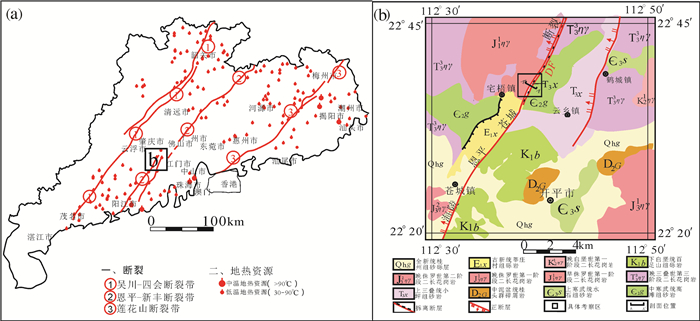
 下载:
下载:


